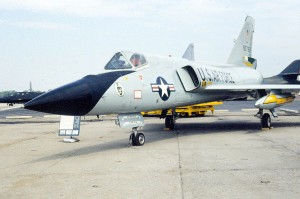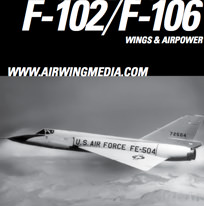The “Cornfield Bomber” was a Convair F-106 Delta Dart, operated by the 71st Fighter-Interceptor Squadron of the United States Air Force, that made an unpiloted landing in a farmer’s field in Montana, suffering only minor damage, after the pilot had ejected from the aircraft. The aircraft, recovered and repaired, was returned to service, and is currently on display at the National Museum of the United States Air Force.
This individual F-106A Delta Dart was manufactured by Convair, later part of General Dynamics, during 1958, and received the tail number 58-0787. Serving with the 71st Fighter-Interceptor Squadron based at Malmstrom Air Force Base adjacent to Great Falls, Montana, a routine training flight, conducting aerial combat maneuvers, on February 2, 1970 ended when the aircraft entered a flat spin.
The pilot, Gary Foust, attempted to recover, including the desperation move of deploying the aircraft’s drag chute; but recovery proved to be impossible, and Foust fired his ejection seat and escaped the stricken aircraft at an altitude of 15,000 feet (4,600 m).
The reduction in weight and change in center of gravity caused by the removal of Foust and the ejection seat caused the aircraft, trimmed for takeoff and with the throttle at idle, to successfully recover itself from the spin.
One of the other pilots on the mission is reported to have radioed Foust during his descent under his parachute that “you’d better get back in it!”.
Foust watched incredulously as the now-pilotless aircraft descended and skidded to a halt in a farmer’s field near Big Sandy, Montana. Foust drifted into the nearby mountains; he was later rescued by local residents using snowmobiles.
Shortly thereafter, the local sheriff arrived at the scene of the crash, and was surprised when he observed the aircraft – the heat of the crash landing, combined with the exhaust from the still-idling jet engine, melted the snow which allowed the aircraft to start to move. Having contacted the air base, he was informed that he should simply allow the jet to run out of fuel, which occurred an hour and forty-five minutes later without further incident.
A recovery crew from McClellan Air Force Base arrived on the scene and began to dismantle the aircraft, removing its wings for transport aboard a railroad flat car. The damage to the aircraft was minimal; indeed, one officer on the recovery crew is reported to have stated that were there any less damage he would have simply flown the aircraft out of the field.
 Following its misadventure, the “Cornfield Bomber” was repaired and returned to service, operating with the 49th Fighter-Interceptor Squadron, the final USAF unit to operate the F-106. Upon its retirement, it was presented to the National Museum of the United States Air Force, where it remains on display.
Following its misadventure, the “Cornfield Bomber” was repaired and returned to service, operating with the 49th Fighter-Interceptor Squadron, the final USAF unit to operate the F-106. Upon its retirement, it was presented to the National Museum of the United States Air Force, where it remains on display.
[hr4]



